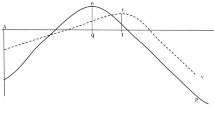Abstract
The change of welfare for one individual can be measured by the compensating variation (CV) or equivalent variation; the change for a whole society can be evaluated by summing up the individual gains and losses (e.g. Σ CV). Generally there is no equivalence between the positive sign of this sum and a potential improvement for all individuals by redistribution of incomes. In this paper the Σ CV-measure is corrected in a manner such that the new measure is equivalent to the Pareto principle. This correction is defined in a general equilibrium framework and takes into account the attainability of allocations. Finally characterizations of compensation tests are derived.
Similar content being viewed by others
References
Boadway RW (1974) The welfare foundations of cost-benefit analysis. Econ J 84:962–939
Boadway RW (1976) The welfare foundations of cost-benefit analysis — a reply. Econ J 86:359–361
Bruce N, Harris RG (1982) Cost-benefit criteria and the compensation principle in evaluating small projects. J Polit Econ 90:755–776
Debreu G (1951) The coefficient of resource utilization. Econometrica 19:273–292
Foster E (1976) The welfare foundations of cost-benefit analysis — a comment. Econ J 86:353–358
Mishan EJ (1972) Cost-benefit analysis. George Allen and Unwin, London
Mishan EJ (1976) The use of compensating and equivalent variations in cost-benefit analysis. Economica 43:185–197
Ng YK (1977) Towards a theory of third-best. Public Finance 23:1–15
Ng YK (1979) Welfare economics. MacMillan, London
Smith B, Stephen FA (1975) Cost-benefit analysis and compensation criteria: a note. Econ J 85:902–905
Author information
Authors and Affiliations
Additional information
The author thanks D. Elixmann and U. Schweizer for helpful comments. The suggestions of an editor of this journal and of two anonymous references are gratefully acknowledged
Rights and permissions
About this article
Cite this article
Ebert, U. On the relationship between the Hicksian measures of change in welfare and the Pareto principle. Soc Choice Welfare 1, 263–272 (1985). https://doi.org/10.1007/BF00649261
Received:
Accepted:
Issue Date:
DOI: https://doi.org/10.1007/BF00649261



